If you visit Pompeii, you find the ruins of a sophisticated town, with a number of seaside villas depicting a luxurious lifestyle. If you visit the Ostia, on the mouth of the River Tiber, you will find buildings which are impressive in quite a different way. This was once a successful commercial port with warehouses, shops and offices, as well as the usual urban amenities: bath complexes, public latrine, temples and so on. It is well worth a visit.
 The Decumanus Maximus, the well-preserved main street in Ostia Antica
The Decumanus Maximus, the well-preserved main street in Ostia Antica
As you can see from the photo above, Ostia was a significant place of some importance. It began as a fortified settlement in the 4th century BC, protecting the commercially important salt pans – essential in food preservation. In theory, Ostia was in an excellent position for industrial expansion but there were problems. The Tiber’s many tributaries were constantly silting up; Ostia’s harbour facilities were rudimentary and didn’t have the depth necessary to take big cargo ships; and the surrounding marshes bred mosquitoes – which meant malaria.

The Emperor Trajan, who oversaw the transformation of Ostia into a large and successful port.
The Emperors Claudius (AD 41-54) and, later, Trajan (AD 98-117) were determined to change all that; and, over the next 60 years or so, they built the enclosed harbour at Portus a couple of miles north of Ostia specifically to take the grain ships from Rome’s new Carthaginian territories of Africa Proconsularis, and dug a canal linking the harbour at Portus to the river Tiber so that the vital grain could be ferried up to Rome. They also built, warehouses, a protective wall and a lighthouse.
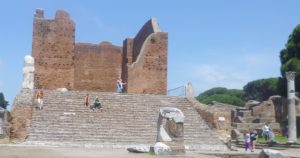
The impressive Capitolium at one end of the forum showed the world that the citizens of Ostia respected the gods.
Ostia became an important naval base with all the facilities one would expect from a wealthy port. There was a substantial forum with a large Capitolium built on an exceptionally high platform just off the main road into Ostia, the Decumanus Maximus. A Capitolium was the most important temple in any town and it was always dedicated to the three main Roman gods, Jupiter Optimus Maximus (Jupiter, the best and the greatest); his consort Juno, the goddess of women, especially wives and mothers, and the protector of marriage; and Minerva, the Roman equivalent of Pallas Athene, the Greek goddess of war, wisdom, and the patroness of various important urban crafts, such as weaving.
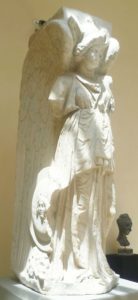
The goddess Minerva
Minerva can always be identified by her attributes. As goddess of strategy, wisdom, and war in the name of justice, she wears a helmet, and she carries the aegis, a round shield covered in goatskin, with Medusa’s head in the centre – a sight so terrifying that it turned anyone who caught its gaze to stone.
Rome allowed its people to worship whichever gods they wanted, but there was a proviso; everyone had to be prepared to acknowledge Jupiter as the first and most important. It was a requirement which many Christians felt they must refuse, and it led, inevitably, to their persecution.
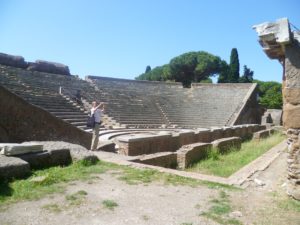
The theatre could seat 3000 people
There were other important buildings off the Decumanus Maximus, too, for example, a small brick theatre, probably a gift from Marcus Agrippa, friend and colleague of the Emperor Augustus, to Ostia in thanks for its support during the Punic Wars against Hannibal. The theatre was later enlarged to seat 3000 people.
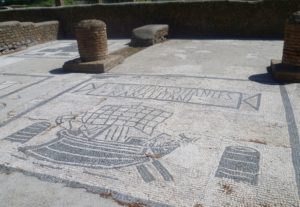
Mosaic in front of the Navicularii et Negotiantes Karalitoni trading post in the Piazzale delle Corporazioni, the commercial area of Ostia
Behind the theatre is the Piazzale delle Corporazioni, a large square surrounded by 70 rooms. This was a commercial area where traders from all over the Roman world set up shop and did business. Their various trades are shown in the lively black and white mosaics fronting the individual shops which tell us where the owners came from and what they traded in. The mosaic above belongs to the Shippers and Merchants of Cagliari, a large port on the south coast of Sardinia, immediately opposite what is now Tunisia. My medieval historian brother, (Latin is practically his second language) translated it for me and told me that it was probably a guild, or part of one, which dealt in grain; and the barrels on either side of the ship depicted in the above mosaic may represent barrels of grain.
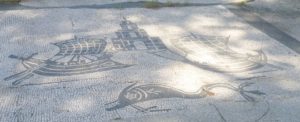
The mosaic above shows the Ostia lighthouse in the background, with a trading vessel on the left and a dolphin in the foreground which symbolizes protection– a sort of divine insurance for the shopkeeper and his customers, perhaps.
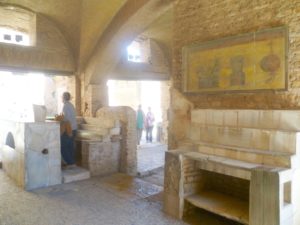
The exceptionally well-preserved bar
Along the Via Casa de Diana are the insulae, the tenements were ordinary people lived. Nearby, the Insula of the Thermopolium has a well-preserved pub – complete with roof and there’s even a fresco above the bar – if rather an undistinguished one. Somehow, this tavern has managed to preserve the pub ambience; it looks as though it’s open for business.
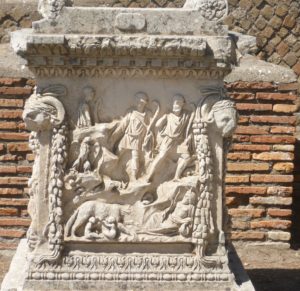
A small altar to Romulus and Remus; you can see the twin brothers in the bottom left hand corner suckling from the she-wolf. Behind, three shepherds stand amazed. The marble has been robbed out, exposing the Roman brick work.
The bar and the altar in particular beg the question – exactly how was so much of the town preserved for posterity? Ostia was not almost instantly covered in volcanic ash or pyroclastic flow, that deadly mixture of hot gases and lava which overwhelmed Pompeii and Herculaneum within days. Instead, Ostia went into rapid decline in the 3rd century and people began to leave. This exodus was accelerated partly by the silting up of the various branches of the Tiber, and partly because of barbarian attacks from the sea. As Ostia emptied, people began to use it as a source for building material; most of the marble went, as did various examples of Classical art.
But it was the silting, together with the expansion of the malarial marshes, which saved the town for posterity. Nobody wanted to live there anymore and, Ostia was gradually buried in mud. And there it stayed. It wasn’t until the eradication of the malarial swamps in the 20th century that Ostia Antica was rediscovered. The first archaeological excavations took place in 1938-42.

Granary of Epagathus and Epaphroditus
This quality of the preservation at Ostia is particularly visible in the Granary of Epagathus and Epaphroditus, which has a most impressive portal to its granary warehouse – but then, the grain brought from North Africa was by far Ostia’s greatest import. Whoever Epagathus and Epaphroditus were (their names are Greek, so they might have been freedmen who made good), they were plainly doing very well, financially.
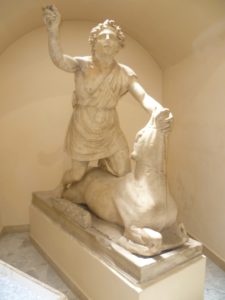
Marble statue of Mithras slaying the bull
Ostia also has a small but interesting museum which houses has a number of interesting statues, like the above statue of Mithras slaying the bull – Ostia also had the Baths of Mithras with, presumably, a mithræum attached. The cult of Mithras originated in Persia and it is not surprising to find evidence for it in this cosmopolitan port.
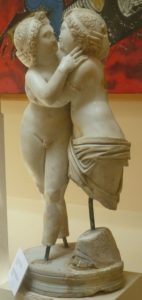
Small marble statue of Cupid and Psyche embracing
The tale of Cupid and Psyche is a late comer to Greek legends. We know of it from Apuleius ‘s The Golden Ass. Apuleius himself flourished around 150 AD but The Golden Ass is almost certainly based on earlier folk tales – it is the author’s skilful story-telling which made the story of Cupid and Psyche famous. It is particularly appropriate that the statue above dates to the period when Ostia itself began to flourish.
Ostia is very easy to get to from Rome, there are good transport links and it takes about half an hour. I recommend it.
Elizabeth Hawksley
Please share this page...
Fascinating! I don’t know anything about Ostia, so all this is new to me. You seemed to have had a lovely day for the trip.
Thank you for your comment, Jan. Ostia seems to be largely a hidden gem, I don’t know why it’s not better known. In its own way, it’s as fascinating as Pompeii – but far less crowded! It’s got a good cafe, too, and decent loos; what more could one ask?!
Never heard of this one. Certainly looks worth a visit. I especially like that you can see how ordinary people lived, which is quite a rarity. The cosmopolitan nature of the place is also interesting.
Thank you for your comment, Elizabeth. If you google Ostia Antica there’s a lot of information (and some great photos), about it; it seems to be on a lot of people’s ‘unknown treasures of Italy’ list! I happily spent a day there and I’m delighted to introduce you to it.
Interesting post, Elizabeth. I knew about Ostia and it is on my to-visit list so it was lovely to see your photos. So nice that it isn’t too crowded!
I’m sure you won’t be disappointed when you finally get there, Gail. I really enjoyed seeing how the business side of Ostia worked – and I loved the mosaics in front of the shops showing where the owners came from and what they did; for example, a picture of an elephant indicating a trader from Africa.
Seems like a very interesting little city. Something about the mosaics in front of the shops really conjured up an image of daily life in another era. Next time I am near Rome I shall have to go and visit.
Thank you for your comment, Huon. I don’t think you’d be disappointed.